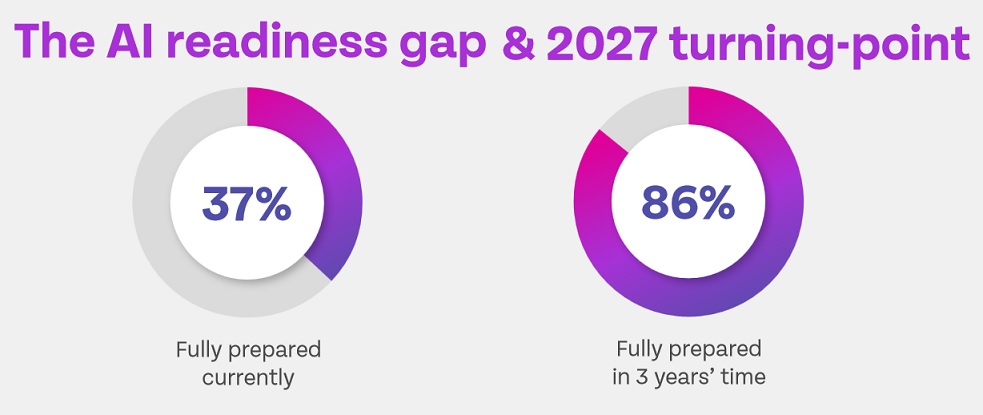
Organizations are gearing up to let the AI rubber hit the road in business initiatives, having spent the past several years implementing AI models mostly to improve IT and operations.
According to a recent survey, organizations see AI as critically important to their futures, with 94% of respondents saying that AI was a top priority of C-suite executives, and 64% of decision-makers saying they plan to use AI to drive growth initiatives and new business models over the next three years. Decision-makers acknowledge, however, that work is needed in order to take full advantage of AI's transformative capabilities. Only 37% said they are fully prepared to implement AI projects right now, but 86% said they expect to be ready by 2027 — presenting a mismatch of AI expectations versus reality.

For IT leaders, a few hurdles stand in the way of AI success. They include concerns over data quality, security and the ability to implement projects. Understanding and addressing these concerns can give organizations a realistic view of where they stand in implementing AI — and balance out a certain level of overconfidence many organizations seem to have — to enable them to make the most of the technology's potential.
Data Quality a Top Concern
Perhaps the biggest concern is over the quality of data. Leaders understand that high-quality data is essential to training AI models and ensuring efficient performance — 85% said so — but most acknowledge that their own data is currently lacking in completeness and accuracy. Only 43% described their data as excellent for quantity and completeness, and 40% rated the accuracy and integrity of their data as excellent. Overall, 69% questioned the effectiveness of using their organization's data for AI.
Without improvements, data quality could become a major stumbling block, as 42% of decision-makers said that a lack of high-quality internal data for training AI models would prevent them from investing more in the technology.
Security-related issues also could deter further AI investments, with 43% citing cybersecurity risks and 36% identifying regulatory and compliance concerns as potential reasons to hold back. More than three-quarters of respondents (76%) are concerned that their use of AI could result in AI accessing their proprietary data in the public domain.
These factors play into questions about the ability to implement AI projects, which has sometimes been a struggle for some organizations. Implementation challenges are evident in the disparity between organizations' confidence in their AI abilities and the results of projects they've completed. Although 82% of decision-makers say their organizations are either significantly or slightly ahead of the competition in implementing AI, only 18% outperformed expectations while 23% underperformed and 59% met expectations.
Observability and Improved DEX Help Overcome AI Challenges
It's clear that organizations are focused on AI because of its potential to deliver substantial competitive advantages. And the research shows that high-performing companies, or growth companies, are those giving AI higher priority than moderate or low performers.
In moving forward, there are several interrelated factors organizations can focus on to help AI's potential become a reality.
Prioritize Observability. When it comes to improving IT and digital services, decision-makers emphasize the importance of observability, which collects and analyzes full-system telemetry to measure the health of a system, detect issues, identify dependencies and improve performance. Observability has been shown to have a significant impact on improving data quality — a top concern with moving forward on AI. 84% of respondents said they want an AI observability platform as opposed to implementing point products.
Tap Into the Successes of High-Performers. Research has also found a clear connection between those who made the most use of AI and those who performed the best. These "high performers" are those organizations with an average change in revenue of 10.5% or more, and they happen to be leveraging AI to its absolute full capabilities (67%) when compared to low performers (45%). Organizations looking to implement AI successfully, like high performers, should be prioritizing similar strategies to ensure performance of models and data. Confidence in data is significantly higher in the top performers when compared to the low performers (53% vs. 28%).
Focus on Improving the Digital Experience. Across all respondents, the survey showed that decision-makers were deploying different AI capabilities to improve digital user experience. 85% said AI-driven analytics improve user experience, while 86% said AI automation is important to improve IT efficiency and deliver an improved digital experience for end users.
Cultivate Young Employees. Millennial and Generation Z employees, who will comprise 74% of the workforce by 2030, are by far the most attuned to AI, with 52% of Gen Z and 39% of millennials having a favorable view of AI, as opposed to Generation X (8%) and baby boomers (1%). They also are the most insistent on good DEX. A Riverbed survey last year found that 68% of decision-makers said poor DEX would drive younger employees to leave the company, putting a company's AI strategy front and center for business growth too.
Conclusion
Organizations are moving in a positive direction, with 92% having formed a department or team to address some combination of AI, user experience and observability, with 57% dedicating an internal team or department to AI and 45% targeting DEX and/or observability.
Using observability to improve data quality and system reliability, building on the work of high-performing, AI-conversant employees and focusing on improving the digital end user experience can go a long way toward setting organizations up for AI success.
